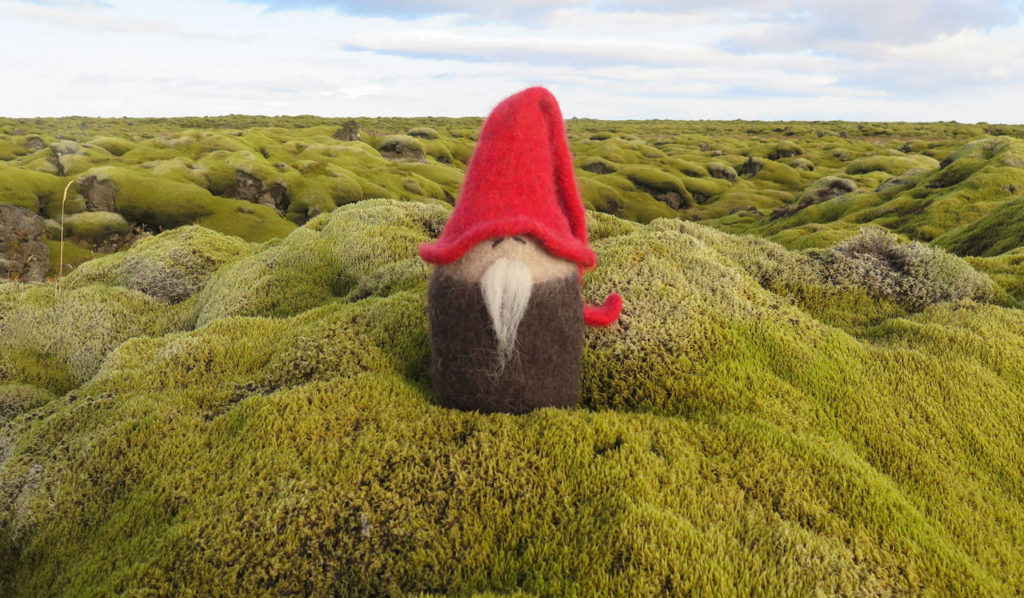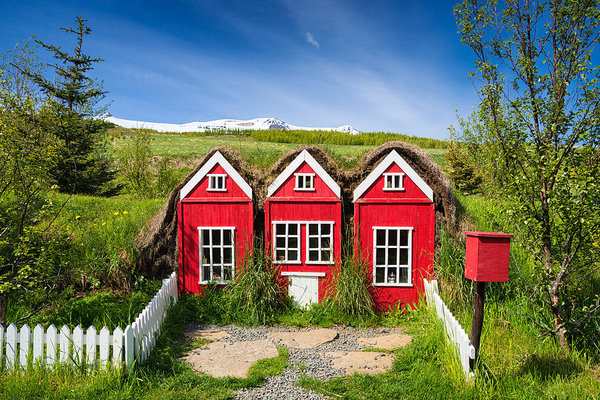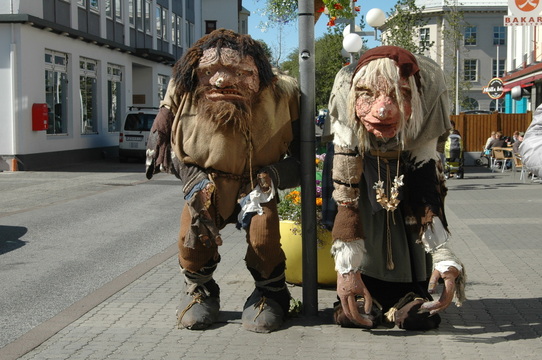

Many people think that the hidden people in the land of fire and ice are just elves. However, hidden people actually includes the many different types of beings that are rarely, if ever, seen here. In addition to elves, there are trolls, dwarfs, gnomes, fairies, mountain spirits and ghosts. There are also a variety of monsters.
Icelandic folklore includes many fascinating and frightening stories that I plan to talk about in future episodes of this podcast. As a primer for future shows, I have decided to give you an overview of these different hidden beings in this episode.
Elves – The Most Popular of the Hidden People in Iceland
Elves are by far the most well-known of the hidden people here because media sources have printed that the majority of the population in Iceland believes that they exist. The funny part is thing is that while many Icelandic people won’t say they absolutely do believe in elves, a good chunk of them won’t say outright that elves do not exist. It is as if they don’t want to make a decision just in case elves really do exist. I find it amusing. The story of how elves came to be hidden people is quite sad and is related to Christianity. Iceland became a Christian nation in the 11th century. With the religion came fascinating stories and there a couple of scenarios that explain the origins of elves.

How Elves Came Into Existence
The first is that Adam and Eve had many children in the Garden of Eden. In preparation for a visit from god, Eve tried to clean all of her children. Unfortunately, she didn’t finish cleaning all of them in time. She hid the dirty ones away from god and lied about their existence because she was ashamed. According to Jón Arnarsson, who wrote Icelandic Legends, god knew that Adam and Eve had more children that were hidden. God said to Eve, “What man hides from God, God will hide from man.” Those unwashed children then became invisible. It is believed that the children that were not hidden from god are us, the people that you see all over the world.
The 2nd scenario of how elves originated is that they come from Lilith, a figure in Jewish mythology that appears as a dangerous demon in the darkness. She is said to be sexually wanton and steals babies in the night. According to Jewish mythology, she was Adam’s first wife but she left him because she didn’t want to become subservient to him. She left the Garden of Eden and became involved with an archangel Samael. The last scenario is that elves are fallen angels that are condemned to live between heaven and earth.
These beings looks like humans and they live in rocks and hills. Icelandic people have a lot of respect for the homes of elves and they generally do their best to avoid disturbing them. Roads have been built around areas or rocks that elves are said to live. Sometimes a medium that can communicate with elves is consulted before construction is done in an area that might be inhabited by elves.
Where to Find Elves in Iceland
If you are wondering where you can find elves, there are many places around the country where they are said to dwell. One very popular place is the Elf Stone in Grjótaþorp, the oldest neighborhood in Reykjavík. Another is along the south coast. It is quite a huge rock near Skógafoss that has some incredible stories attached to it. Because it is on a farmer’s land, you would have to ask permission to see it up close.

There are also doors that have been painted on rocks around the country and some people have tiny houses that they set up in their gardens for elves to live in. In addition to possibly meeting an elf out in the wilderness by chance, there are certain times of the year when it is said that the odds of a person coming in contact with an elf is higher. On New Year’s Eve there are bonfires happening around the country. That night is when elves usually move their residence from one rock or hill to another.
On the Thirteenth night, January 6th, which is the last day of Christmas in Iceland, Icelanders come together around bonfires to sing songs about elves and trolls. Lastly, on Midsummers Night, which is the longest day of the year, if you sit at a crossroads where all four roads lead to separate churches, an elf will try to seduce you with gifts. If you accept the gifts, you will go mad but if you resist the temptation, your wishes will come true. In my episode called Icelandic Holidays, Traditions & Celebrations, I talk about all of the major holidays that Icelandic people celebrate.
Trolls
Recently, I have talked quite a bit about trolls because of the Christmas season. You might recall that Grýla, the mother of the 13 Yule Lads is a troll that eats children that misbehave. Like many Nordic portrayals of trolls, they are described as bigger, stronger and less intelligent than humans. Some are considered greedy, but they can also be wise and kind. Similar to elves, they can cast magical enchantments and nasty spells. They are said to live in the mountains in the highlands of Iceland.

The highlands of Iceland is uninhabitable for humans to live in, which is probably why trolls call it their home. Most trolls travel at night time because legend has it that they turn to stone if caught in the sunlight. There are numerous rock formations around Iceland that Icelandic people claim are trolls that were caught in natural light. One famous group of stones can be seen from the black sand beach near Vík on the south coast. Apparently, the trolls were trying to drag in ships to the shore but were hit by the light of day. When we are traveling in Iceland, my husband enjoys pointing out rock formations that look like faces or bodies and saying they must be trolls that were petrified into stone. Because some trolls like to eat people, I don’t advise trying to find where they live.
Ghosts
There are plenty of ghosts stories in Iceland and I look forward to sharing many of them with you in future episodes. As you would expect, Icelandic ghosts are not usually friendly. In Iceland, they seem to go after specific people or families for centuries. They can cause bad luck, kill people or drive them mad. There have even been incidents where people have allegedly been sexually assaulted by ghosts. Some women have been impregnated by a former suitor that is dead. There is also a story about a horse stable that is haunted by a guy that attacks men he finds attractive. This might sound silly but guys are afraid of turning their back in the stable because that is when the ghost attacks. Women seem to be of no interest to this particular ghost.
Some other stories include The Deacon of Myrká and Miklabæjar Sólveig. There is even a ghost center in Stokkseyri that is dedicated to Icelandic ghosts and elves. It is about 45 minutes outside of Reykjavík by car.
Icelandic Monsters
The monsters in Iceland are just as intense and scary as you would assume. Well, maybe even more so. One of the most famous is Lagarfljotsormur (aka the worm monster). It is essentially this country’s Loch Ness monster. It lives in Lagarfljót, a body of water in the north of the country. There is supposed footage of it and you can check it out below.
Another fascinating monster is Nykur a gray horse with backwards hooves that lives underwater. It might sound kind of cute, but if you get too close Nykur it will lure you into the water, drag you under and drown you. It will do this to any wanderer it finds in the wilderness, Icelandic or foreign.
I won’t list all of the monsters now because I think they deserve their own episode.
Random Fact About Iceland
- The University of Iceland conducted a study in 2007 that found that an estimated 62% of the nation believe that the existence of these beings is more than a fairy tale. This statistic covered sincere believers and agnostics who lean toward the ‘why not’ end of the spectrum.
- Magnús Skarphéðinsson founded and runs the Elf School in Reykjavík. According to the Elf school website:
“He has met personally more than 900 Icelanders that have seen and met and talked with elves and hidden people in Iceland or have had a long friendship with them, – and met more than 500 foreigners in these 40 countries he has done researches in also. Mr. Skarphedinsson is also one of the leader of the Paranormal Foundation of Iceland. – All the lectures in the Elf school are in English.”
Magnús Skarphéðinsson
Icelandic word of the episode
Huldufólk – hidden people
Let’s be social! Here is where you can connect with me on social media platforms:
I hope you enjoyed learning about Iceland’s hidden people. I release a new podcast episode every week. Make sure you are subscribed to the All Things Iceland podcast so you don’t miss new episodes. If the platform you are listening to this podcast on allows you to leave a review, please do so, if you haven’t already.
Þakka þér kærlega fyrir að hlusta (og að lesa) og sjáumst fljótlega
Thank you kindly for listening (and reading) and see you soon!